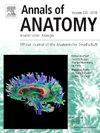Geometric morphometric analysis of body shape and sexual dimorphism in Colossoma macropomum
IF 2
3区 医学
Q2 ANATOMY & MORPHOLOGY
引用次数: 0
Abstract
Background
This study investigates sexual dimorphism in Colossoma macropomum using geometric and linear morphometrics.
Methods
A total of 26 specimens (14 females, 12 males) were analysed through shape analysis (MorphoJ) and linear measurements (ImageJ). Statistical analysis of both linear and geometric morphometry was performed using the PAST program.
Results
Geometric morphometric analysis identified statistically significant differences in body shape between males and females. Females were characterised by a shorter and narrower body form, while males exhibited a longer and broader morphology. Notably, the caudal fin base's flexion axis, along with the position and length of the anal fin, were highlighted as key anatomical regions for distinguishing between adult males and females. Linear morphometric analysis further revealed significant sex-specific variations, particularly in the head region and anterior body width.
Conclusion
The findings integrate quantitative data from linear morphometric with visualised results from geometric morphometric analysis, providing a detailed assessment of morphological distinctions. Potential drivers of these differences, including reproductive strategies, feeding behaviours, population density, genetic structure, aquaculture practices, water depth, and ecological niche differentiation, were explored to explain the observed sexual dimorphism. This research provides valuable insights into the morphological variation and evolutionary mechanisms underlying sexual dimorphism in Colossoma macropomum, with implications for species management and conservation. Moreover, it represents a novel contribution as the first comprehensive study to utilise geometric morphometric techniques to elucidate shape differences between male and female individuals of this species.
巨巨巨像体型和性别二态性的几何形态计量学分析
本研究利用几何形态计量学和线性形态计量学研究了巨像的两性二态性。方法通过形态分析(MorphoJ)和线性测量(ImageJ)对26只标本进行分析,其中雌性14只,雄性12只。使用PAST程序对线性和几何形态进行统计分析。结果几何形态计量学分析发现男性和女性的体型有统计学差异。女性的特征是身体更短更窄,而男性则表现出更长更宽的形态。值得注意的是,尾鳍基部的弯曲轴,以及肛鳍的位置和长度,被强调为区分成年雄性和雌性的关键解剖区域。线性形态计量学分析进一步揭示了显著的性别差异,特别是在头部区域和前体宽度。结论该研究结果结合了线性形态计量学的定量数据和几何形态计量学分析的可视化结果,提供了形态差异的详细评估。这些差异的潜在驱动因素包括繁殖策略、摄食行为、种群密度、遗传结构、水产养殖实践、水深和生态位分化,以解释所观察到的性别二态性。本研究为巨形巨像的形态变异和进化机制提供了有价值的见解,对物种管理和保护具有重要意义。此外,它代表了一个新颖的贡献,作为第一个综合研究,利用几何形态计量学技术来阐明该物种的雄性和雌性个体之间的形状差异。
本文章由计算机程序翻译,如有差异,请以英文原文为准。
求助全文
约1分钟内获得全文
求助全文
来源期刊

Annals of Anatomy-Anatomischer Anzeiger
医学-解剖学与形态学
CiteScore
4.40
自引率
22.70%
发文量
137
审稿时长
33 days
期刊介绍:
Annals of Anatomy publish peer reviewed original articles as well as brief review articles. The journal is open to original papers covering a link between anatomy and areas such as
•molecular biology,
•cell biology
•reproductive biology
•immunobiology
•developmental biology, neurobiology
•embryology as well as
•neuroanatomy
•neuroimmunology
•clinical anatomy
•comparative anatomy
•modern imaging techniques
•evolution, and especially also
•aging
 求助内容:
求助内容: 应助结果提醒方式:
应助结果提醒方式:


